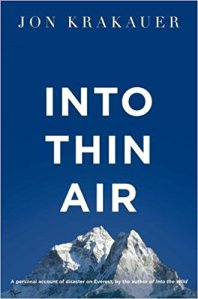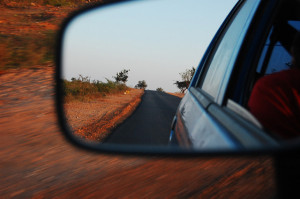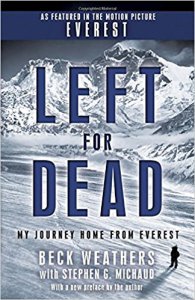Read these three books, my friend gushed, and you’ll experience a gummy, disorienting waltz with truth, memory, and trauma.
 Krakauer, Jon. Into Thin Air: A Personal Account of the Mount Everest Disaster. Jon Krakauer, Narr. New York: Random House Audio, 2007. CD.
Krakauer, Jon. Into Thin Air: A Personal Account of the Mount Everest Disaster. Jon Krakauer, Narr. New York: Random House Audio, 2007. CD.
Genre: nonfiction memoir
Summary: Krakauer documents his experiences during the Mount Everest disaster in 1996 when 8 climbers died in a horrendous blizzard. He traces the many conflicting motives and oversights which may have contributed to deadly mistakes.
Critique: Recently, a good friend challenged me to read what she calls the “Mount Everest Disaster Trilogy.” Three survivors’ accounts—Krakauer being one—of what happened or failed to happen on the mountain during a significant storm that claimed over a dozen lives. The three accounts overlap as often as they contradict. The experience of reading all three, my friend assured me, was a gummy, disorienting waltz with truth, memory, and trauma.
Because my friend is the Cookie Monster when it comes to nonfiction, I accepted the challenge with all due gravitas.

“RoadTrip” (CC BY 2.0)
With a couple hundred miles between me and my winter holiday destination, I picked up the audio book edition of Krakauer’s famous (some say infamous) memoir read by the author himself. The controversies surrounding his memoir were and are many. Did Krakauer skew the narrative, effectively tilting more blame on the excursion guides, Rob Hall and Scott Fischer—two of the world’s best who also died in the blizzard—only to overshadow his potential cowardice? Should he have come out with a magazine article and a memoir so swiftly on the heels of the tragedy? Was this insensitive to grieving families? Was he even in a fit state of mind to recount the events? To his credit, Krakauer acknowledges each of these pressure points and does his best to relieve them. Also to his credit, he did not rely solely on his own memory. He conducted interviews with other survivors and the memoir includes testimonies that totally upend his own recollections.
After listening to the first disc, I was stupefied by the structural design or chaos the writer had chosen. The narrative jumped…no, it ricocheted between Krakauer’s setup and backstory (his youth spent climbing, how a travel magazine hired him to ascend the mountain with a guided expedition) and historical background on the first attempts to top Everest in the early 1900s.
By trade, nonfiction writers are daring and innovative with structure. How could they not when the genre’s granddaddy, John McPhee, structured his writings around everything from lowercase letters to tennis courts or the Monopoly board? But Krakauer’s construct was verging on pure genius. So disorienting! Surely he was trying to give readers the felt experience of high altitude sickness and its reality-bending deliriums.
As the CD carousel switched to disc 2, I reached for the pause button. No way was it safe to drug my attention while driving!
Then, I saw it: my car’s audio player was set to shuffle! Krakauer’s structure was not deliberately disordered or artfully rearranged. As it turned out, his structure was nothing out of the ordinary—a straightforward progression through times and places and events.
Actually, Krakauer’s style included a rather obtrusive, rather clockwork habit: every time he introduced a new “cast member,” he paused the unfolding events on Everest so that a minutely detailed account of that person’s life up to that moment could be shared. Among writers, this longwinded setup is known as the “info dump,” and it is generally discouraged in fiction and nonfiction because it pulls the reader away from the main attraction. Of course, plenty of writers skillfully employ these tangents to create tension and knot up the suspense. No doubt Krakauer aimed for that very effect.
While I cannot report his aim hit the mark for me, I can say it approached the bull’s eye whenever I switched on the shuffle button.
 Next up in the Mount Everest Disaster Trilogy: The Climb: Tragic Ambitions on Everest by Anatoli Boukreev and Left for Dead: My Journey Home from Everest by Beck Weathers. Boukreev was employed with one of the expedition guides on Everest. His ability to scale the mountain’s 29,000+ feet was practically unmatched, often ascending without an oxygen tank. Krakauer accused Boukreev of negligence in 1996 because he went without oxygen while guiding clients to the top. The alleged result: when the storm hit, Boukreev was in no condition to help anyone. Not surprisingly, Boukreev’s book rebuts this depiction.
Next up in the Mount Everest Disaster Trilogy: The Climb: Tragic Ambitions on Everest by Anatoli Boukreev and Left for Dead: My Journey Home from Everest by Beck Weathers. Boukreev was employed with one of the expedition guides on Everest. His ability to scale the mountain’s 29,000+ feet was practically unmatched, often ascending without an oxygen tank. Krakauer accused Boukreev of negligence in 1996 because he went without oxygen while guiding clients to the top. The alleged result: when the storm hit, Boukreev was in no condition to help anyone. Not surprisingly, Boukreev’s book rebuts this depiction.
Beck Weathers was one of the paying climbers being guided to Everest’s summit. No less than three times, he was literally left for dead. Each time, he managed to slog his way out of danger or recover just enough from severe hypothermia and frostbite. To be sure, while listening to Krakauer explain his and others’ decisions to leave Weathers behind I often cried, “Foul!” Selfish cowardice colored the reasons in neon strokes. Yet, Weathers’ memoir reportedly spends little time finger-pointing and more time exploring life’s true value, especially in the wake of second, third, and fourth chances.
(Featured image “Everest” CC BY-NC-ND 2.0.)
Advertisements Share this:




